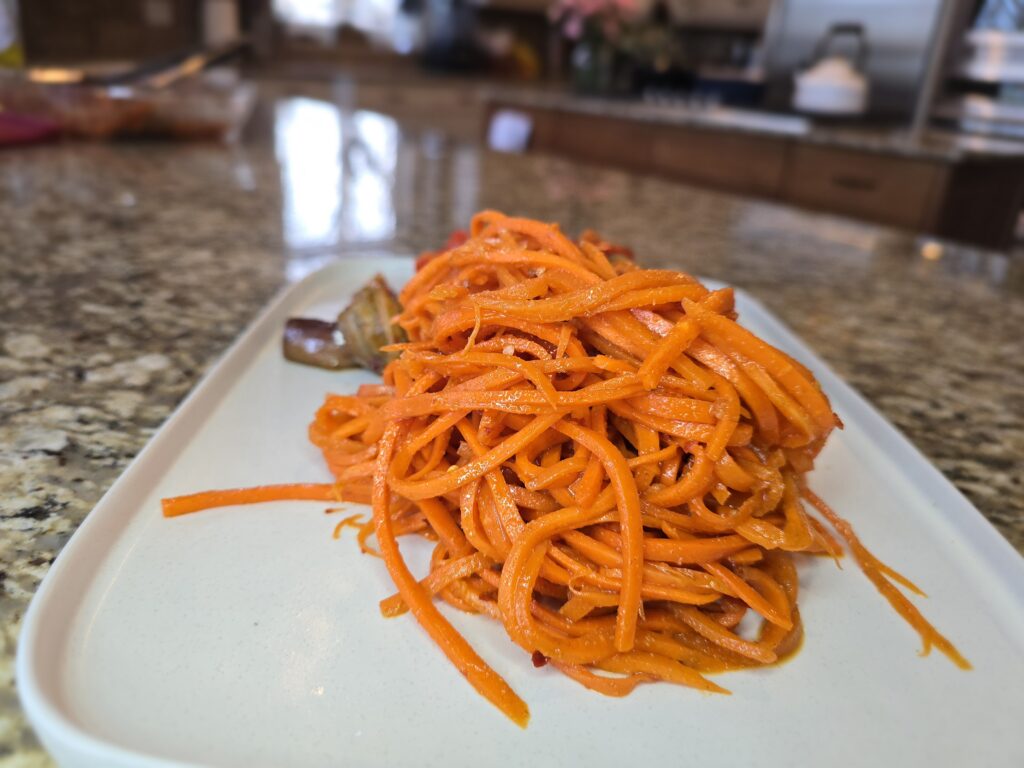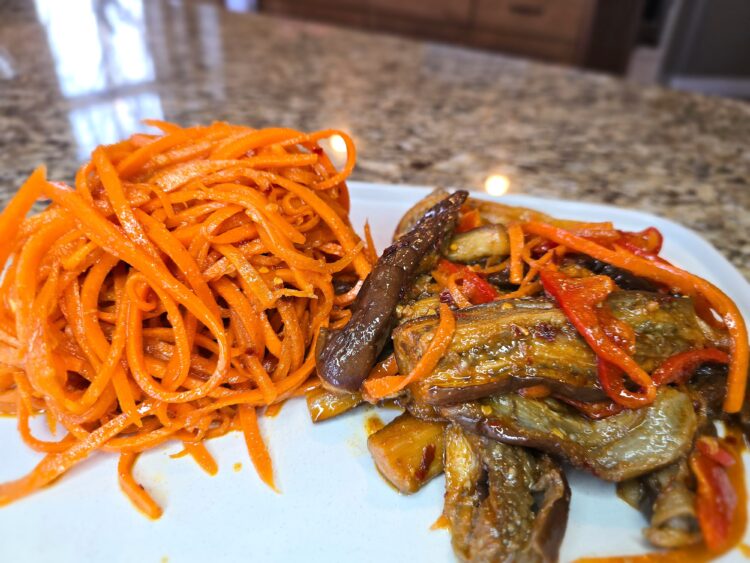The Story of Korean-Style Carrot and Eggplant Salads: A Dish of Nostalgia and History
This is not just a recipe—it’s a memory, a taste of home for many, and a dish that carries with it an entire history of resilience, migration, and cultural fusion. If you grew up in the former Soviet Union, these salads were everywhere—sold at open-air bazaars, in small kiosks, and by street vendors. Whether scooped into plastic containers or served alongside family meals, they were a staple. But despite their widespread presence, their origins are far from ordinary.

Why “Korean” Carrots?
The name “Korean-style” (корейская морковь / морковча) often confuses those unfamiliar with its history. This is not a traditional Korean dish but rather a creation of the Koryo-saram—ethnic Koreans who lived in the former Soviet Union. Their story is one of displacement and adaptation.
In the 1930s, under Stalin’s orders, thousands of Koreans who had settled in the Russian Far East were forcibly deported to Central Asia—Kazakhstan and Uzbekistan in particular. These families, torn from their homes, had to rebuild their lives in unfamiliar lands. They brought with them their culinary traditions but faced a challenge: many of the ingredients common in Korean cuisine, such as Napa cabbage and daikon radish, were difficult to find in Central Asia.
In an act of adaptation, they recreated their beloved kimchi using what was available—carrots. Shredded finely, marinated in vinegar and spices, and bloomed with hot oil, this new dish became a vibrant, tangy, and garlicky salad that retained the essence of their original kimchi while evolving into something entirely unique.
Over time, the dish spread far beyond Koryo-saram communities. It became beloved across the Soviet Union, served in homes, restaurants, and markets. The bright orange salad, spiced with coriander and chili, became a fixture at celebrations and everyday meals alike. Today, it remains a nostalgic favorite for many.
Eggplant Joins the Table
The Korean-style eggplant salad (баклажаны по-корейски) followed a similar journey. As the Koryo-saram integrated into Soviet society, their dishes continued to evolve. Eggplants, widely available in Central Asia and the Caucasus, became another ingredient transformed through Korean-style seasoning.
This dish mirrors the carrot salad in its balance of tangy vinegar, garlic, and heat, but with the addition of soft, roasted (or fried) eggplant, sweet bell peppers, and onions. The eggplant absorbs flavors deeply, making this a richer, more savory counterpart to the crisp and refreshing carrot salad.
Both salads share a similar preparation method, including blooming the spices in hot oil—an essential technique that intensifies the flavors and sets these dishes apart from simple vinegar-based salads.
A Taste That Travels
Despite its deep roots in the former Soviet Union, Korean-style salads have since traveled worldwide. Today, they can be found in Russian and Ukrainian delicatessens, enjoyed across Eastern Europe, and even recognized in parts of Korea as an unexpected but appreciated diasporic dish.
For many, these salads are more than just food—they’re a direct connection to childhood, family gatherings, and the aroma of bustling markets. They represent the ingenuity of a people forced to adapt and a culinary tradition that continues to thrive.
Every bite carries history—the warmth of garlic, the tang of vinegar, the heat of chili, and the unmistakable scent of coriander, an ingredient so characteristic of Soviet Korean cuisine that it has become almost synonymous with it.
Why This Recipe Matters
If you grew up eating this, you know that not all versions are equal. Many recipes online cut corners, leaving out the careful steps that bring out the real depth of flavor. Proper moisture removal, correct vinegar balance, spice blooming—these details matter. This is a dish that, when done right, is vibrant, tangy, and rich in umami.
For those who have never tried it, this is an opportunity to experience one of the most beloved street food-style salads from the post-Soviet world. Whether served as a side dish, tucked into sandwiches, or eaten straight from the bowl, these salads are more than just food—they’re a story of migration, adaptation, and cultural resilience.
And once you taste them the way they’re meant to be made, you’ll understand why they’ve stood the test of time.
Korean-Style Carrot & Eggplant Salads (Моркoвча & Баклажаны по-корейски)
Ingredients
- Korean Carrot Salad (Моркoвча)
1 lb (450 g) carrots, peeled and grated into long thin strips
3–4 cloves garlic, minced (adjust to taste)
2–3 tablespoons vinegar (typically 9% table vinegar in post-Soviet regions, but you can use white vinegar or apple cider vinegar; see other substitutions in the Notes)
2 teaspoons sugar (or to taste)
1 teaspoon fine salt (or to taste)
1 teaspoon ground coriander (or freshly ground coriander seeds)
1 teaspoon chili flakes or ground chili (adjust to your heat preference)
½ tsp paprika, optional
Optional additions: a dash of soy sauce or sesame oil (less traditional but tasty), a pinch of black pepper
- Korean-Style Eggplant Salad (Баклажаны по-корейски)
2–3 medium eggplants (about 1–1.5 lbs total), sliced into batons
1 bell pepper, thinly sliced (optional for color and texture)
3–4 cloves garlic, minced
3 tablespoons vinegar (again, typical is 9% table vinegar, but you can adjust)
1 tablespoon sugar (to taste)
1 teaspoon fine salt (plus more for salting eggplants)
1 teaspoon ground coriander
1 teaspoon chili flakes (or to taste)
½ tsp paprika, optional
Optional: soy sauce, sesame oil, black pepper, sliced hot peppers
- ☀️ The Bloomed Oil (For Both!)
⅓ cup sunflower oil (or another neutral oil)
Directions
- Place the sliced eggplants in a colander and sprinkle generously with salt. Let sit for 20–30 minutes to draw out excess moisture. Rinse and pat dry.
Cook the eggplants:
Option A (Fry): Shallow-fry in a pan with oil until lightly browned and soft. Drain on paper towels.
Option B (Roast): Toss with oil, spread on a baking sheet, and roast at 400°F (200°C) for 20–25 minutes, until soft and golden.
In a large bowl, combine the cooked eggplants and julienned bell pepper.
Add the sugar, coriander, chili flakes, optional paprika and minced garlic. Toss well.
Pour in the vinegar and stir everything together. Add some of the carrots from Step 2 for colour. - Place the julienned carrots in a large bowl. Sprinkle with salt and let them sit in a colander for about 15–20 minutes to draw out some moisture, then gently squeeze them.
Add the sugar, coriander, chili flakes, optional paprika and minced garlic. Toss well.
Pour in the vinegar and stir everything together. - Heat the oil: In a small saucepan or skillet, heat the vegetable oil until it’s hot but not smoking.
Pour hot oil over the vegetables and spices: Immediately drizzle half the hot oil over the seasoned carrots; drizzle the other half over the eggplant. You’ll hear a satisfying sizzle, which “blooms” the spices. Mix quickly to distribute the oil and spices throughout the vegetables. - Marinate: Let the salad rest in the fridge at least a couple of hours (or overnight) so the flavors meld. Adjust sweetness, acidity, and salt to taste before serving.
Notes
- Tips for Adjusting to Lemon Juice or Sushi Vinegar (Although 9% Vinegar is ideal, these are some of the substitution ideas:
Flavor balance:
Lemon juice is less acidic than standard white vinegar, so you may need a bit more to achieve the same tang. Taste as you go.
Sushi rice vinegar is already sweetened and salted, so reduce added sugar and salt initially. You can always add more later.
Milder taste:
Lemon juice will give a fresh, bright citrus note.












This is now the only way that I’ll eat carrots. It tastes like a vietnamese vermicelli bowl, without all of the… everything other than carrots and flavour.
Amazing! lol